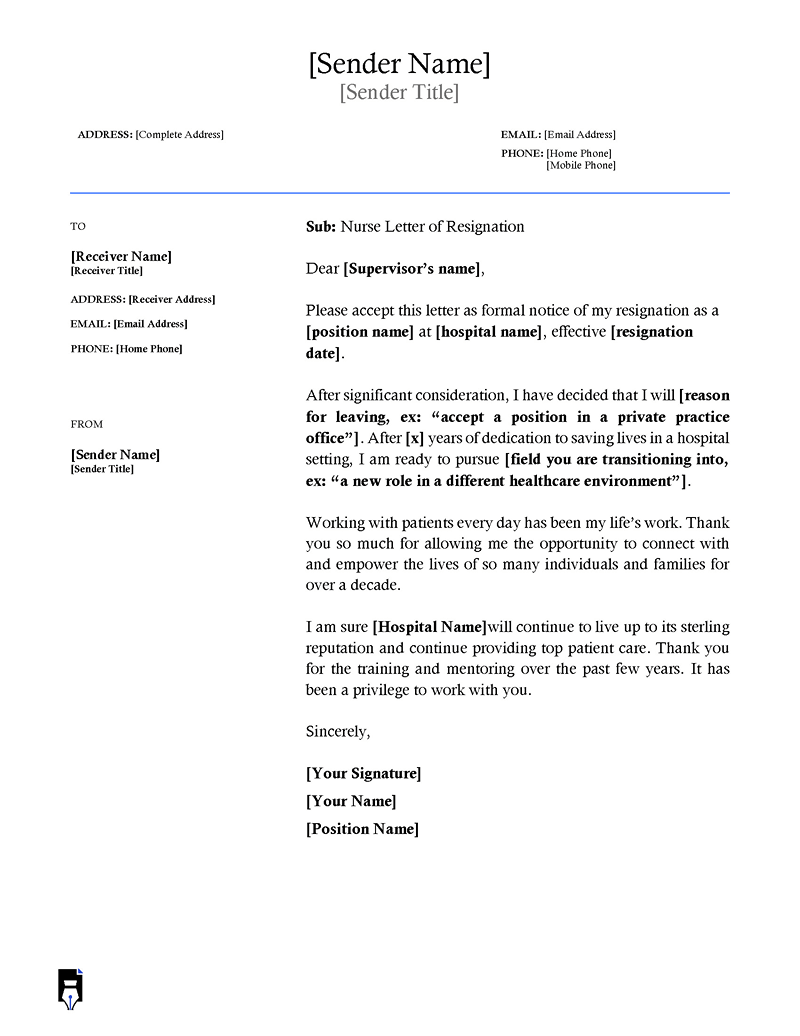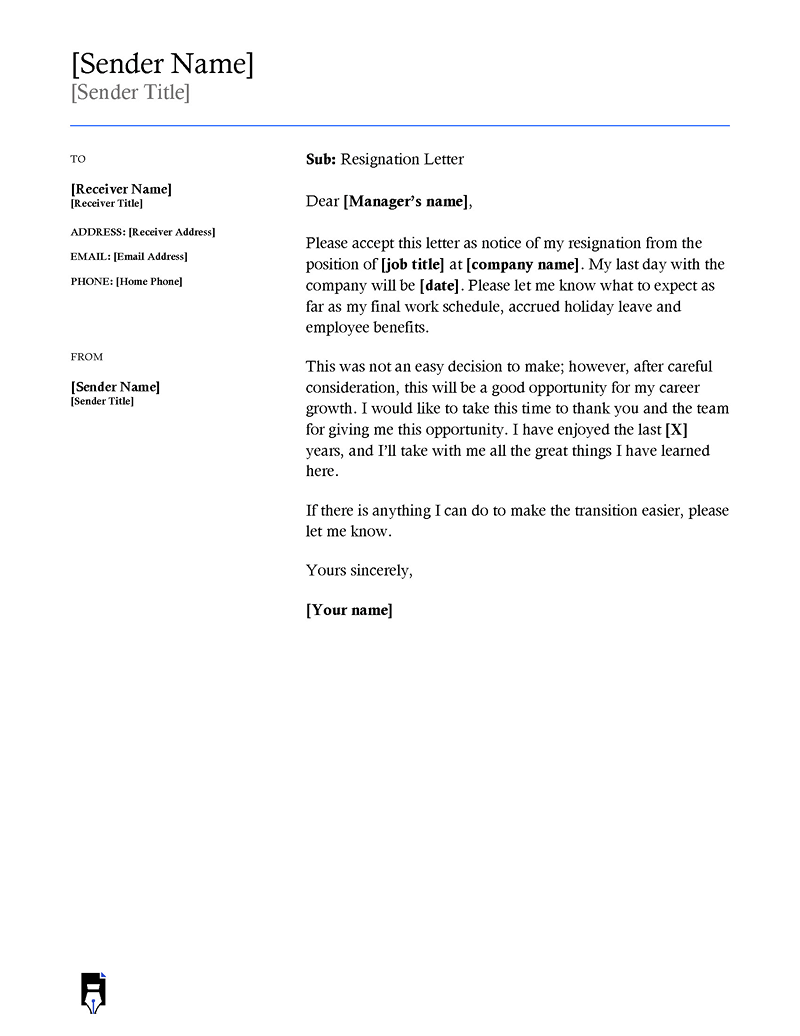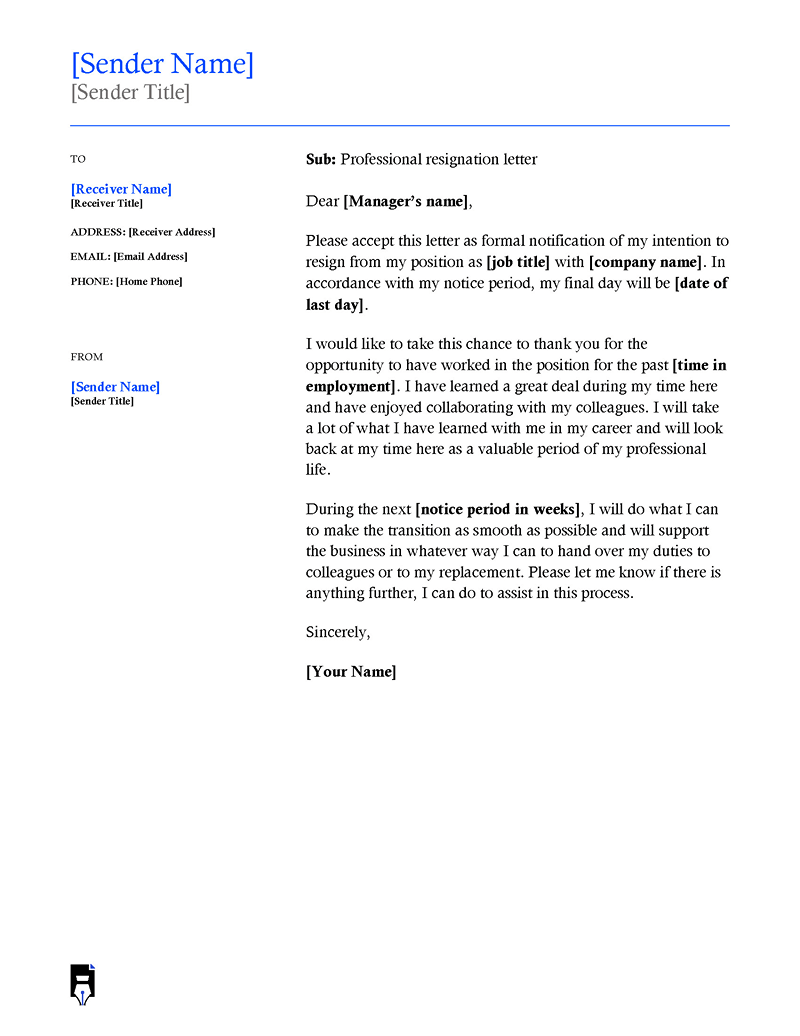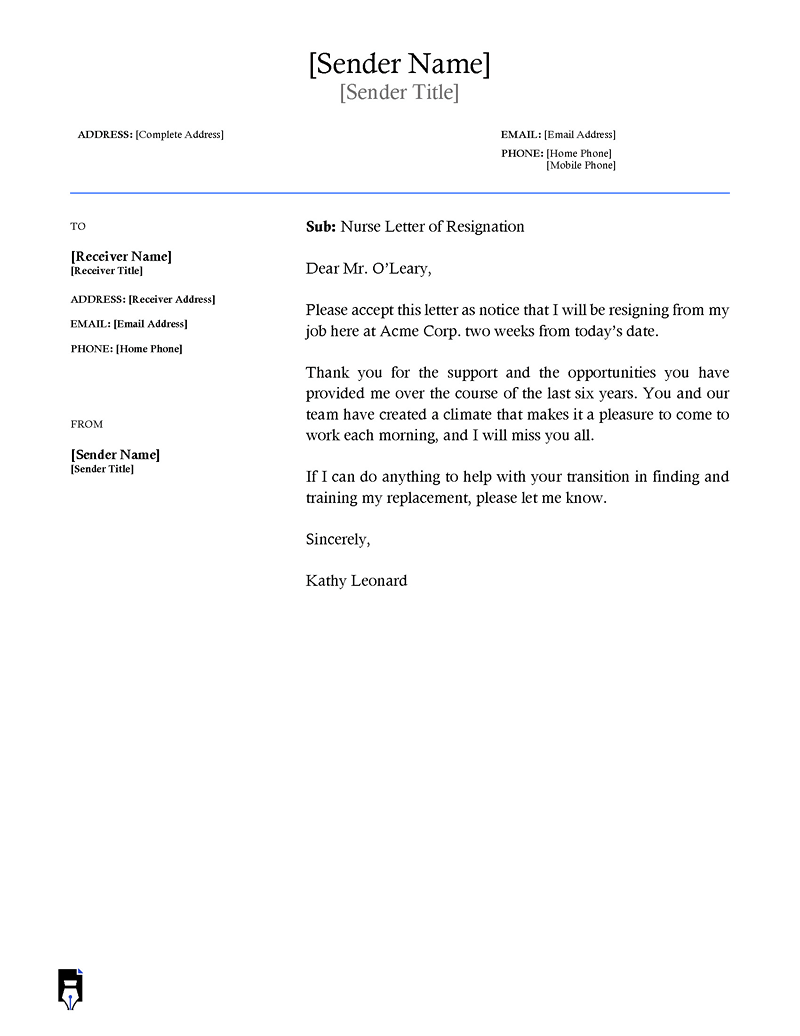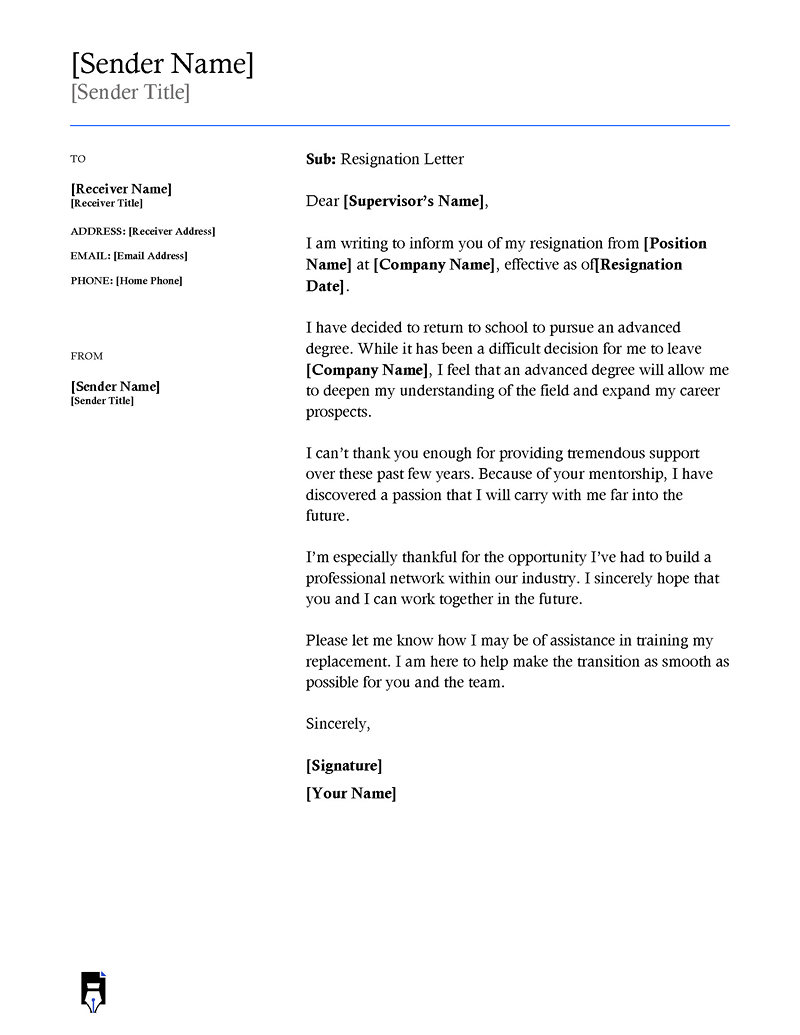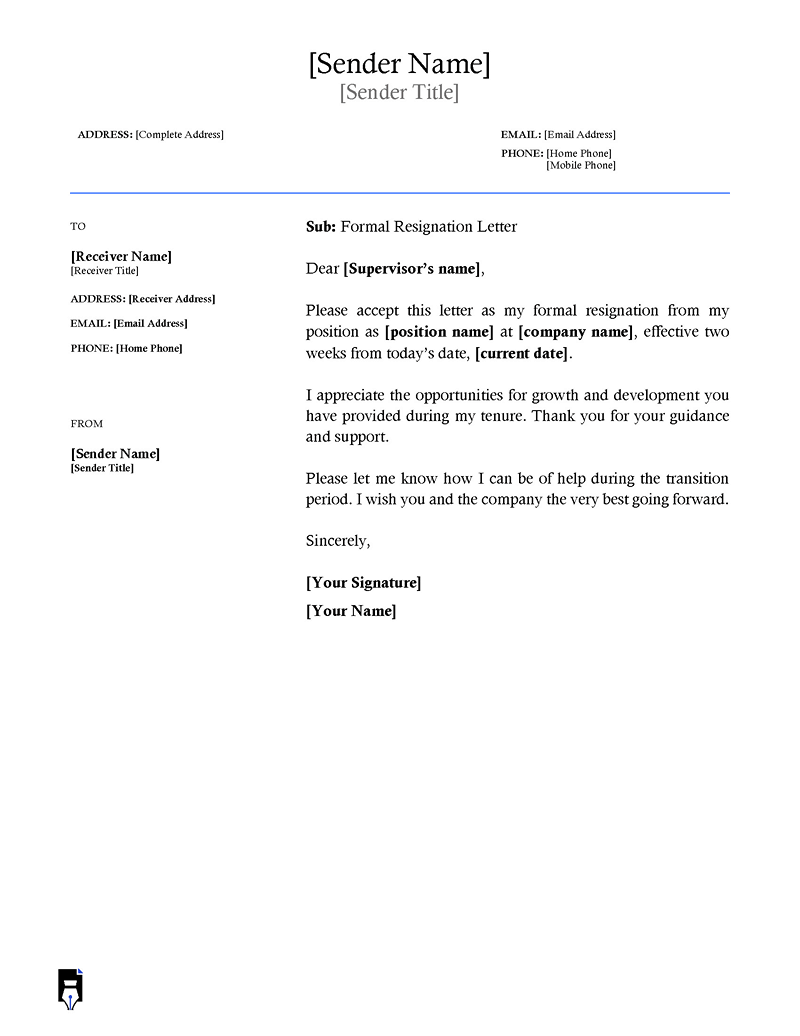A resignation letter is a formal document prepared by an employee to inform the employer that they intend to leave the job.
The letter should be written once you, as an employee, have notified your employer of your desire to leave the organization in person or through email. It is an official and respectful way of ending your current employment.
With at least two weeks’ notice, ensure that you prepare a resignation letter so as to provide your employer with details of your resignation plans, such as your employment end date. Keep in mind that this letter is not just required out of professional etiquette; the HR department also needs it to act as evidence of your departure from the company.
Based on your employment contract, you may or may not be required to prepare this document. If it is a requirement, ensure that you check the rules and regulations that the company expects you to follow as you resign from work. If it is not a requirement, it is a polite gesture to write it, so as to maintain a professional relationship with your employer even after you leave. It also gives your manager enough time to find a replacement for your position.
In this article, you will learn more about writing your resignation letter, the importance of writing it, and the tips to follow.
Resignation Letter Templates
You can download the following templates for free:
Why and When You Should Write Resignation Letter
In regards to a resignation letter, you need to know why and when you should write it. As an employee, here is what you need to know regarding this official document:
Why
As an employee who is quitting their job, you should write a resignation letter since it is required by the HR office. This document is important as it provides a record of your resignation details, such as when you gave your resignation notice and departure date. With proper record-keeping, your transition process from the company will be easier for both you and your employer.
You will need to prepare a resignation letter as a requirement by the company or industry you are in. Ensure that you ask around your company to confirm whether it is customary to write this letter. It is best to reach out to someone in the HR department in a discreet manner. You can also choose to reach out to a previous employee and ask if they submitted a resignation letter when they quit.
Another reason why you should write this letter is to make the resignation discussions with your boss less awkward. It is important to make that conversation in person with your employer. However, if the situation is tough or challenging, start by sending the resignation letter before having the meeting. That way, your employer will be aware of the expected discussions.
Finally, it is necessary to write a resignation letter if you wish to control the story around why you quit your job. Be clear about your departure in your letter and why you have to leave; then send a copy to your manager and the HR department. However, do not provide too many details surrounding the reason why you are leaving. With a copy of this letter, you will reduce the risk of getting bad reference letters due to lies surrounding why you quit your job.
When
Once you have written your letter, it is important to identify the most appropriate time to give your employer the letter. Ensure that you send in your letter in advance with a two weeks notice period. However, there are some situations where you might have to quit your job on short notice, less than the two-week requirement. Such instances include family emergencies, health issues, or a difficult work environment.
You are not required as an at-will employee to give your employer advance notice when you resign. However, if you are an employee with an employment contract, you need to check the terms and conditions of the contract to determine what to do when resigning. As an employee, you can also present your resignation letter when you are telling your employer about your plans to leave the organization.
5 Simple Steps to Write Resignation Letter Successfully
Once you have spoken with your manager about your intentions to end your employment, the next step is to write your resignation letter. Using the steps provided below, you will be able to write an effective letter that clearly highlights your resignation plans.
Ensure that you observe the following steps carefully when writing your letter:
Step 1: State your intent to resign
When writing your letter, start by mentioning the fact that you are resigning. Ensure that you mention the company position you are resigning from and the name of the company.
For example:
I would like to inform you that I am resigning from my position as sales and marketing director of ABC Company.
Note: Before you get to this section of your letter, ensure that you first include the date, your contact information, the recipient’s details, and a proper salutation at the top of the page.
Step 2: Give notice of resignation
Ensure that you state your last day of work so as to provide your employer with proper notice. Make sure that your last day of work provides the employer with about two weeks’ notice. However, check your company policy to determine how much time you need to provide. For your last day at work, include both the date and the weekday.
For example:
My last day at work will be on the Monday of 14th November, 2022. That will be two weeks from today.
Step 3: Ask the questions you may have
Based on your departure plans, you can either include any questions you might have for the transition process or request to meet your supervisor for follow-up questions. The questions might involve your final pay or expected employee benefits.
For example:
As I leave due to health issues, I would like to have a final meeting with my supervisor regarding my final pay and pending employee benefits.
Step 4: Express gratitude for the job
Whatever reasons you might have for quitting your job, it is important to still thank your employer for the job opportunity. Show your gratitude for the experience and career development you have had at the company. This helps you to maintain a positive professional relationship with your employer.
For example:
I am truly grateful for the opportunities and chances I have had as your employee. I have really expanded my knowledge about the industry, created numerous networking relations, and achieved most of my career objectives. As your employee, I would like to say thank you.
Pro tip: In your resignation letter, ensure that you use language that urges your employer to maintain the professional relationship you had with them even after you leave the job. This ensures that you create and maintain great networking opportunities.
For Example:
“I have learnt so much while working here at the company, and I hope that we can stay in touch as that will give me an opportunity to gain more knowledge about the industry.”
Step 5: Offer to help with the transition
If possible, offer to help your manager with the transition process. This is professional etiquette meant to offer closure and will likely leave a positive final impression on them. You can interview and train your replacement, take your time to arrange your documents and reports, or even complete your assignments and projects.
If you are unsure about the transition responsibilities your manager will need help with, just mention that you are available and can help with the process. Your employer will most likely specify what you should do if they need your help.
For example:
Please feel free to reach out to me in case you need any help with the transition process. As for now, I will ensure that I have completed all my pending assignments before my departure date. I will also re-assign all of my pending projects to my colleagues in the department. Once again, thank you for the guidance, job opportunity, and professional growth.
Do’s and Don’ts for Writing Professional Resignation Letter
Here are the do’s and don’ts that you should pay special attention to when writing your resignation letter:
Do’s
This is what you should do when writing your letter:
Keep it positive
Your resignation letter must be written in a positive tone. Keep in mind that it is the final impression that your employer will have of you. That means leaving on a positive note is more important than focusing on the negative reasons you might have for quitting your job. You will be able to maintain a professional relationship with your employer and colleagues if you leave a positive final impression on them.
Most importantly, a resignation letter is meant to share details of your resignation plans and not complain or share your feelings of anger and disappointment. Your decision to leave must always be communicated in a respectful and positive manner. The best way to avoid complaints and frustrations in your letter is by sharing your challenges during the exit interview. However, do not create a taint to your professional image by being disrespectful during this final interview.
For both your letter and interview, be positive, remain factual, avoid complaints, and be simple.
Deliver your letter in person
Be sure to print the letter and preferably hand it over to your employer in person. It is possible to deliver your letter through email, but it is more professional to deliver the letter yourself. If you use email, ensure that you include a clear subject line that informs the manager of your resignation intentions. On the other hand, for your printed letter, ensure that you include the date on the top part of the letter.
Write a formal letter
Whether you are emailing or printing your letter, ensure it is formal. A resignation letter is a business letter and must therefore be official. That means that you must be professional and respectful when writing the letter. Also, use traditional fonts such as Times New Roman, Calibri, or Arial to maintain the official nature of the letter. The font size should be between 10 and 12 points.
When formatting, use the single-spaced format but ensure that you leave space between each paragraph. Another important aspect to consider is the margin and alignment. It is best to use one-inch margins with left alignment, as it is a preferred formatting style for business letters.
Don’ts
Ensure that you avoid doing these when preparing your resignation letter:
Avoid writing a lengthy letter
This is a formal letter, meaning you must avoid writing a lengthy one. Your resignation letter should be brief and straight to the point. To achieve this, make your resignation plans clear, include your departure date and highlight your reasons for leaving in a concise manner.
Don’t show off your new job
If you are leaving for a new job, your resignation letter is not a place for you to brag about it. Avoiding this means that you can reach out to your employer for a reference or to be considered for a position at the company. Also, if you are leaving for a new job, the best thing to do is to avoid mentioning it in your letter completely, especially if it pays more than your current salary and you are using this fact to get a counteroffer from your employer.
Avoid giving reasons for your resignation
Finally, it is best to avoid giving reasons for your departure entirely, especially if the reason is negative. Being negative means that you are complaining about your job, bad-mouthing your colleagues, or bragging about how happy you are to leave for your new job. For other respectful reasons, such as personal reasons or even health matters, you can mention them without going into detail.
Final Thoughts
When quitting your job, the most respectful and professional thing to do as an employee is to write a resignation letter. With this document, you can easily inform your employer of your intentions to end your employment and leave the company. A resignation letter is meant to convey your resignation plans and not your complaints about work. It is best delivered in person and with a two weeks advance notice. Ensure that you write it in a formal business style, with a positive tone, and in a brief manner.
